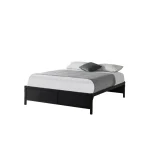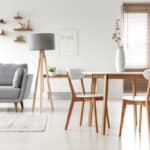What Furniture Features Most Effectively Contribute to Genuinely Calming Spaces in Human Services Environments?

Furniture shapes how people feel, focus, and connect in care and treatment environments. Thoughtful choices support emotional regulation, dignity, and daily functioning for residents and staff alike. By pairing clinical requirements with a welcoming, residential feel, spaces can foster calm, engagement, and therapeutic momentum. This article outlines the features and practices that create truly restorative settings through calming spaces, furniture, calming environment furniture, and carefully selected therapeutic furniture features.
The Healing Impact of Environment in Human Services Settings

Well-designed spaces can lower stress responses, promote consistent routines, and foster trust between individuals and care teams. A room that looks and feels predictable helps people settle faster and participate more willingly. When furniture aligns with therapeutic goals, behavior and engagement often follow. Design becomes a quiet partner to clinical and programmatic work.
The Psychology of Calming Environments
Calm often emerges from predictability and gentle sensory input. Soft textures, stable silhouettes, and balanced visual weight communicate safety without words. Incorporating soothing color furniture ideas, such as muted greens, warm neutrals, and soft blues, reduces arousal while supporting orientation. Equally important are cues of personal control, like movable side tables or task lighting, that encourage independent regulation. In aggregate, these choices function as stress-reducing furniture strategies, providing a foundation for sensory-friendly furniture that supports neurodiverse needs and trauma recovery.
Trauma-Informed and Sensory-Aware Design Principles
Trauma-informed settings emphasize physical and psychological safety, choice, and empowerment. Furniture with rounded corners, non-institutional profiles, and intuitive use patterns lowers perceived threat and supports a sense of belonging. Specifying safe furniture for human services that integrates tamper-resistant details without appearing punitive maintains dignity. Layering trauma-aware design furniture with tactile warmth, clear sightlines, and seated zones for privacy strengthens therapeutic furniture features by meeting body, mind, and environment in a coherent whole.
Function and Flexibility – Designing for Adaptable Care Spaces

Care environments accommodate individual therapy, group work, family visits, and daily living within the same footprint. Spaces benefit from modular systems that shift quickly to match changing goals throughout the day. This agility supports autonomy, reduces visual chaos, and keeps teams responsive. When movement is easy and quiet, residents experience fewer disruptions and greater control.
Multi-Functional Furniture
Multi-purpose pieces stretch square footage while maintaining visual calm. Storage ottomans, convertible benches, and nesting tables reduce clutter and keep essentials within reach. The right mix balances display and concealment, helping people focus without constant stimuli. Specifying commercial furniture for care facilities that includes integrated charging, wipe-clean surfaces, and intuitive grips supports safe everyday use. These details, paired with therapeutic furniture features, deliver the versatility associated with calming spaces furniture in active program areas.
Modular Designs and Mobility
Modular seating lets staff and residents quickly shift from individual reflection to small-group dialogue to larger circles. Lightweight construction and concealed handles help move pieces without strain, while stable bases prevent tipping. Quiet glides and rubberized casters cut noise during reconfiguration, reinforcing calm. Selecting commercial furniture for care facilities with reliable joinery and replaceable parts sustains longevity. This approach doubles as a stress-reducing furniture strategy, keeping transitions smooth and predictable.
Comfort and Well-Being – Supporting the Human Experience
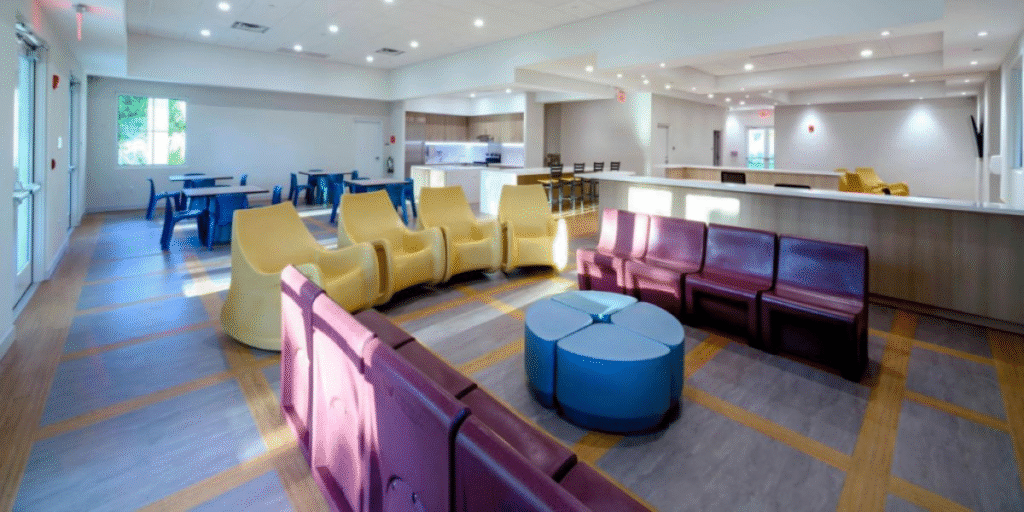
Comfort influences mood, attention, and stamina throughout the day. The right seat height, arm support, and back angle can encourage participation longer and reduce fidgeting. Tactile warmth and visual softness contribute to perceived safety. A calm baseline helps residents self-regulate and helps staff conserve energy for direct care.
Ergonomic and Supportive Seating Options
Ergonomics in care settings go beyond standard office metrics. Seats should support natural posture, with appropriate lumbar support and armrests that ease transfers without pinching or hard edges. Varied seat depths accommodate different body types and mobility levels. Thoughtful, supportive seating options help residents remain present during therapy and community activities. In program lounges and dining areas, this directly aligns with comfort-focused furniture and the goals of commercial furniture for care facilities that must perform daily without losing a welcoming feel.
Warm and Soothing Material Choices
Material palettes influence emotional tone. Matte finishes, softly textured upholstery, and rounded wood edges feel familiar and grounded. Upholstery with a pleasant hand communicates welcome while meeting cleaning and durability needs. Coordinating soothing color furniture ideas with flooring and wall tones avoids visual noise and glare, which can overstimulate. Together, these moves expand the reach of calming environment furniture, creating a consistent language of comfort across rooms and routines.
Adjustable and Personalized Comfort
Adjustability grants agency. Recline features, seat-height options, and movable tablet arms make it easier to find a preferred position without assistance. Task lighting with simple controls supports reading, art, or journaling. These therapeutic furniture features invite self-tuning of sensory input, aiding de-escalation and focus. This is the heart of comfort-focused furniture and a natural complement to supportive seating options in multi-use spaces.
Safety, Durability, and Hygiene – Foundations of Trust

Trust depends on reliability, both perceived and real. Furniture must withstand continuous use, cleaning, and movement without wobbles or sharp failures. Materials and construction methods should match acuity levels and program activities. Hygiene protocols work best when surfaces are cleaned quickly and look fresh after repeated disinfection.
Durable Materials for Care Settings
High-pressure laminates, solid-core composites, and steel-reinforced frames tolerate constant use and frequent cleaning. Seam placement and edge treatments affect lifespan as much as material choice. Specifying durable furniture for care settings with replaceable components minimizes downtime and waste. This approach supports the operational needs of commercial furniture for care facilities while maintaining the consistent performance associated with stress-reducing furniture that feels stable day after day.
Safety and Ligature-Resistant Features
In higher-acuity areas, safety features require careful balance with dignity. Weighted bases, concealed fasteners, and ligature-conscious details reduce risk without signaling punishment. Rounded corners and non-toxic finishes protect skin integrity and support calm. Choosing safe furniture for human services that blends residential lines with protective engineering aligns with trauma-aware design furniture goals. Well-executed details strengthen overall therapeutic furniture features across the unit.
Hygienic and Easy-to-Clean Surfaces
Cleanability impacts well-being and workflow. Moisture-resistant substrates, sealed seams, and healthcare-grade upholstery simplify daily routines and support infection control. Features like zipperless cushions and smooth undersides speed wipe-downs and prevent debris traps. These choices reinforce sensory-friendly furniture by removing odors and visual clutter tied to wear. In turn, maintenance ease contributes to stress-reducing furniture strategies that keep spaces looking cared-for.
Integrating Therapeutic Furniture into Holistic Design
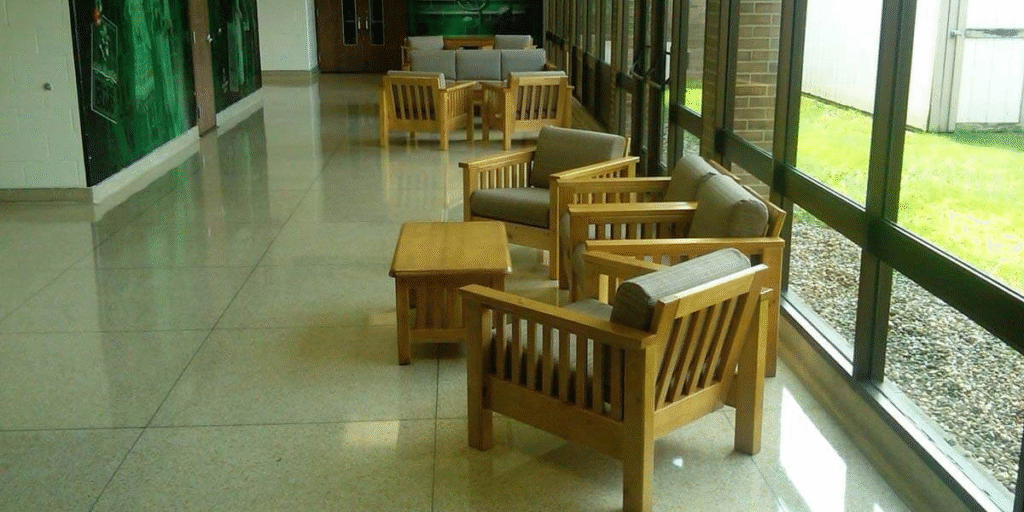
Furniture does its best work when aligned with lighting, acoustics, and circulation. Zoning helps define purpose while keeping paths clear and sightlines open. Clear organization limits confusion and supports wayfinding. Residents read the environment quickly and use it with confidence.
Layouts That Encourage Choice and Connection
Choice fosters dignity; connection builds community. Arrange seating to support multiple postures, including upright conversation, semi-reclined reflection, and side-by-side activities. Position calming nooks away from high-traffic paths, but within visual reach of staff. Using calming spaces furniture to create micro-zones allows quiet and social needs to coexist. These planning moves work well with commercial furniture for care facilities and encourage varied supportive seating options that welcome different bodies and preferences.
Low-Noise and Sensory-Friendly Furniture
Noise spikes can derail progress, especially for sensitive nervous systems. Soft-close hinges, felt floor glides, and rubber casters are effective low-noise furniture materials that tamp down distraction during daily rearrangements. Combine with textiles and finishes that avoid glare and harsh textures to support sensory-friendly furniture goals. This package supports the larger aim of calming environment furniture, lowering stress while preserving everyday function.
The Future of Comfort and Care in Furniture Design

Design trends point toward integration, with performance, sustainability, and inclusion working together. Research continues to clarify which features consistently influence outcomes. Manufacturers are responding with platforms that mix durability and warmth. The trajectory favors products that age gracefully while staying easy to service.
Evidence-Based Innovation
Pilot studies and post-occupancy evaluations illuminate which design elements drive participation and de-escalation. Data informs seat geometry, fabric selection, and layout standards. These insights shape therapeutic furniture features that better match clinical pathways and staffing patterns. Operators benefit when commercial furniture for care facilities comes validated for real-world use; residents benefit through calmer settings reinforced by stress-reducing furniture parameters grounded in evidence.
Sustainable and Inclusive Design
Materials with recycled content, low-VOC finishes, and responsibly sourced woods support health and stewardship. Universal design principles, including clearances, transfer-friendly arms, and readable controls, improve access for everyone. Such moves strengthen sensory-friendly furniture strategies by reducing irritants and barriers. Durable construction and serviceability keep products in use longer, reinforcing durable furniture for care settings while maintaining the welcoming presence of calming spaces furniture across years of operation.
How We at Furniture Concepts Support Calming, Purpose-Driven Spaces
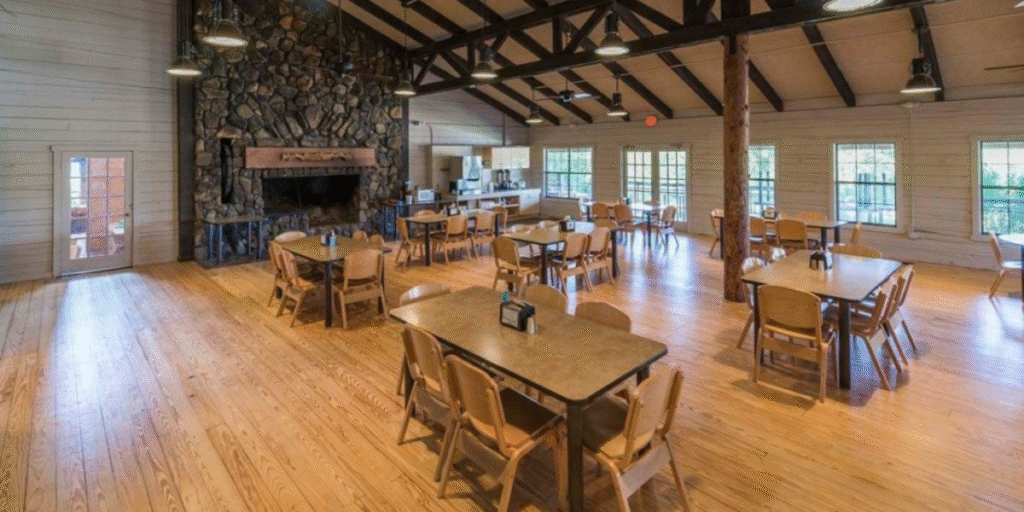
Every program, population, and building presents unique challenges. Collaboration with administrators, clinicians, and facilities teams helps us source and specify products perfectly tuned to actual workflows and acuity levels. The goal is a coherent palette that looks residential, performs clinically, and supports emotional safety. Our implementation support and training help teams get the most from each curated setting.
We at Furniture Concepts work with trusted manufacturing partners to deliver furnishings that meet the distinct demands of behavioral health environments while maintaining the therapeutic atmosphere your residents deserve.
Our Approach to Therapeutic Design
We co-create product selections that align with safety, comfort, and visual dignity. Collections emphasize intuitive use, accessible storage, and fabric systems matched to cleaning protocols. Design workshops translate program goals into room-by-room plans. This process centers comfort-focused furniture, refines supportive seating options, and integrates therapeutic furniture features with materials and finishes that deliver sensory-friendly furniture benefits from day one.
Built for Safety, Comfort, and Connection
As a trusted furniture wholesaler, we carefully curate healthcare furniture that balances safety with comfort. Our selected product lines feature thoughtful details like rounded edges, seamless construction, and easily maintainable components that support long-term care environments. We source low-noise materials that minimize disruptions during daily operations. Our portfolio includes durable, inviting furniture designed to maintain its welcoming appearance through years of intensive use. From assisted living to acute care settings, we supply trauma-informed furniture solutions that combine necessary safety features with residential aesthetics, creating spaces where families, residents, and staff feel at ease.
Conclusion
Calm emerges when space, purpose, and people align. Programs thrive when furniture blends safety, comfort, and adaptability within a familiar, human-centered language. Thoughtful selections, validated by field experience and research, create predictable settings that promote self-regulation, meaningful connection, and daily progress. With the right blend of calming environment furniture, calming spaces furniture, comfort-focused furniture, and safe furniture for human services, teams can deliver care in rooms that quietly heal.
Ready to elevate your home or office with premium furniture that combines style, quality, and functionality? Contact Furniture Concepts now to explore our extensive collection and discover the ideal products that truly showcase your unique style.




